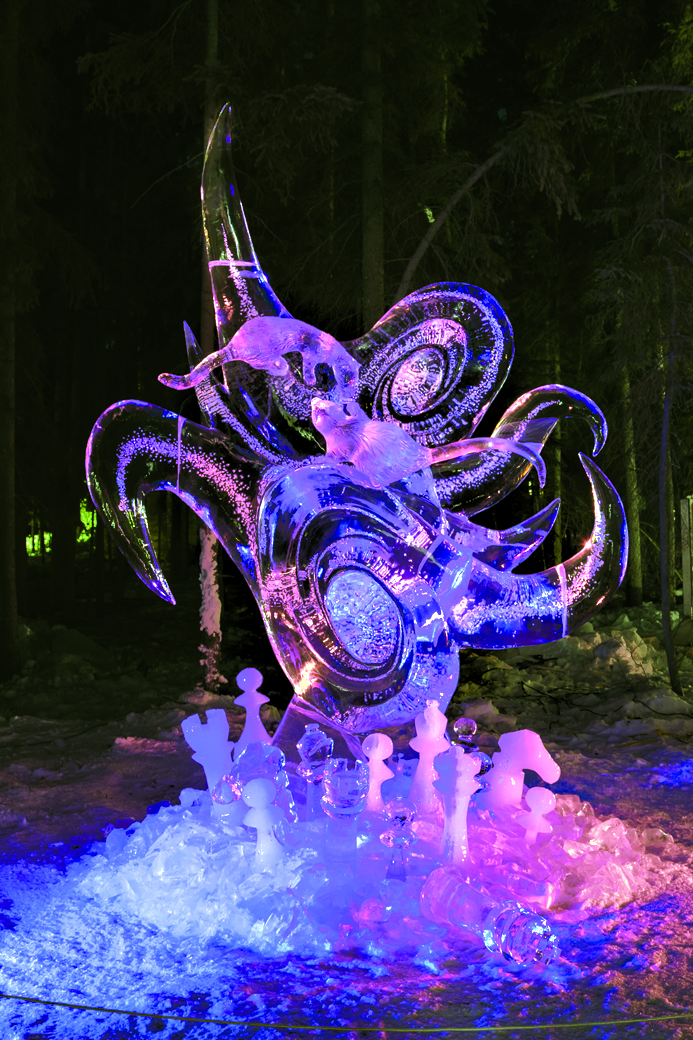Barnabas Firth provided the idea and his father, Ben Firth, perfected the technique. Earlier this month the Anchor Point team wowed the judges of the 2016 BP World Ice Art Championship in Fairbanks and took first place in the single-block, abstract art category for their work, “Nature of Conflict.” The team took home more than $1,000 in prizes.
Barnabas Firth, 25, hadn’t competed in the ice art championship since he was a teenager, but his dad, 52, has been competing and winning in the championship since 1999, when the Firth family lived in Fairbanks. Barnabas said he wanted to compete at least once with his father.
“While I still had an opportunity I told my dad I wanted to do it with him,” Barnabas said. “I managed to pull off the pretty big deal.”
Started in 1990, the World Ice Art Championship has drawn competitors from around the world, including China, Russia, Mexico, Japan, Australia, France, Mongolia and, of course, Iceland. In the single-block competition, artists from 17 countries participated.
The two men weren’t the only Firths competing. Melanie Firth, the mother of the eight Firth children, also has competed before. Son Silas and daughter Aurora Firth competed in the single-block category, realistic, but did not place with “Such is the Kingdom.” The sculpture shows a little girl with her back to a lion, wolf and puma behind her.
“They took on a really challenging idea and they pulled it off pretty well,” Barnabas Firth said.
In the single-block category, teams of two artists have three days to carve their work. The Firths competed separately in the single-block categories, and then joined up in the multi-block category. Teams of four have six days to carve ice. Ben Firth and his children also carved “Sea Snare,” a sculpture of two humpback whales feeding with a bubble net in the realistic category. Barnabas said that category is highly competitive.
“The multi-block realistic is literally the most prestigious competition in the world,” he said.
Barnabas credited his dad with having the technical skill to bring about his idea. The sculpture shows a weasel and rat fighting against a backdrop of colliding galaxies. They’re on a pedestal ringed with chess pieces.
“This was a strange one I kind of came up with,” Barnabas Firth said. “It dropped into my head one day and I couldn’t get it out of my head.”
“He showed me this sketch he had,” Ben Firth said. “He didn’t know if I thought it would make a good sculpture or not, but I could see the potential. I figured out the design of how we would make it.”
Artists work with a single block of ice that’s 8-feet-by-5-feet-by-3 feet. Ice comes from a pond near the ice carving site. Artists can choose their work site, but take the ice given. Barnabas said their piece was relatively clear with few bubbles. Working temperatures were close to 0 degrees at night and in the mid-20s in the day. On some days the temperature got above freezing, so the artists had to shade the work from the sun. Tyvek house wrap works particularly well since it doesn’t stick to ice, Ben Firth said.
Artists use the whole block of ice to make the sculptural elements, and can take pieces out to carve for smaller parts and then reattach by freezing. Tools are used like chainsaws, chisels and angle grinders, with a propane torch to add the finish that gives the work its clear glow.
The Firth family has become known for its artistic endeavors. Barnabas, Aurora, Silas, Sarah and Josiah have all won awards in the U.S. Fish and Wildlife Service Junior Duck Stamp contests, and Aurora and Silas also have won awards in ice carving competitions. Barnabas said he doesn’t consider himself that much of an artist.
“I got up there and realized I was way out of my league,” he said of this year’s competition. “I spent a lot of time asking myself, ‘How do I do this?’”
Part of the calculation is figuring out how to make the elements from one big block of ice. Judges like to have a difficult time figuring out where the blocks of ice are, Barnabas Firth said.
“How did they even do that?” the judges will ask, he said. “That’s a big plus for the judges.”
Judging also is done on things like how well the piece fits the theme of abstract or realistic. Works should be predominantly one or the other, but where do you draw the line?
“That’s a discussion that goes on every year. Some of them are very obvious,” Barnabas Firth said. “It’s all that in between. It depends on what the artist is trying to communicate.”
For “Nature of Conflict,” the big abstract elements are two colliding spiral galaxies. Ben Firth had the idea of carving stars in the back of the spirals.
“The way it worked out, the ice had all these curves. It magnified it in places and shrunk it in places,” Ben Firth said.
Barnabas Firth said that was the nice thing about working with his father.
“I had the idea, but I didn’t know the medium,” he said. “You had to think about how to make it better in the ice. He was the one who made it spectacular. He was the one able to take my idea and execute it well.”
Ben Firth’s approach with the spirals helped them win, the son said.
“When you walk past it, it swirls because of the light throwing it,” Barnabas Firth said. “It really wowed the judges because of the technique we used.”
“It was a lot of fun,” Ben Firth said of working with his son. “I really enjoyed being able to do that with him.”
Michael Armstrong can be reached at michael.armstrong@homernews.com.


